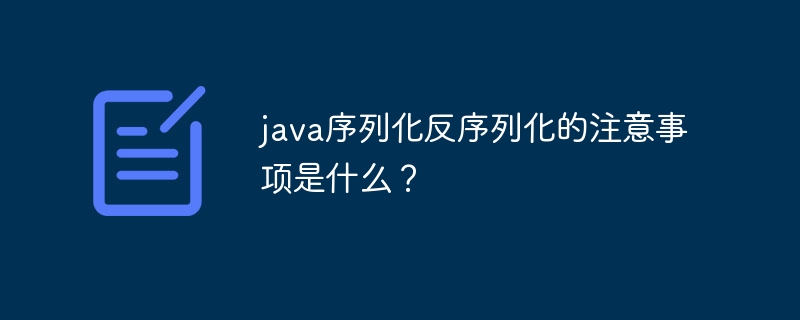
Java serialization/deserialization considerations: Only serialize object types that need to be persisted. Mark serializable classes using the Serializable interface. Use the transient keyword to modify fields that should not be serialized. Make sure the object is properly initialized after deserialization. Consider virtual machine compatibility. Use version control to resolve serialization compatibility issues.

Java serialization/deserialization considerations
Java serialization and deserialization are the conversion of the state of an object The process of taking a stream of bytes and persisting them to a file or transmitting them to a network. Deserialization refers to the process of reconstructing an object from a byte stream. While this is convenient in Java, the following needs to be noted to avoid potential security and efficiency issues:
1. Serializing object types
Serialize only Classes that require persistence. Do not serialize classes that implement a serialization interface (such as Serializable or Externalizable) but have no actual need for persistence.
2. Serialization interface
Use the Serializable interface to mark classes that can be serialized. This interface provides writeObject() and readObject() methods for use by the Java serialization mechanism.
3. Transient fields
Use the transient keyword to modify fields that should not be serialized. This prevents these fields from being populated during deserialization, improving performance and security.
4. Proper initialization
Ensure that the object is properly initialized after deserialization. This is because Java only sets field values during deserialization and does not call constructors or initialization blocks.
5. Ensure virtual machine compatibility
Consider serialization/deserialization of virtual machine compatibility. Different versions of the Java Virtual Machine may have different serialization behavior, so ensure that objects can be serialized on all target platforms.
6. Version control
Solve serialization compatibility issues caused by class changes. Maintain versioning by using the serialVersionUID field or a custom serialization mechanism.
Practical case:
import java.io.FileInputStream;
import java.io.FileOutputStream;
import java.io.ObjectInputStream;
import java.io.ObjectOutputStream;
public class Main {
public static void main(String[] args) throws Exception {
User user = new User("John", "Doe");
// 序列化对象
try (FileOutputStream fos = new FileOutputStream("user.ser");
ObjectOutputStream oos = new ObjectOutputStream(fos)) {
oos.writeObject(user);
}
// 反序列化对象
try (FileInputStream fis = new FileInputStream("user.ser");
ObjectInputStream ois = new ObjectInputStream(fis)) {
User deserializedUser = (User) ois.readObject();
System.out.println(deserializedUser.getName() + " " + deserializedUser.getSurname());
}
}
}
class User implements java.io.Serializable {
private String name;
private String surname;
// 考虑使用 `serialVersionUID` 以确保序列化兼容性
private static final long serialVersionUID = 1L;
public User(String name, String surname) {
this.name = name;
this.surname = surname;
}
// 实现 `getName()` 和 `getSurname()` 方法
}The above is the detailed content of What are the considerations for java serialization and deserialization?. For more information, please follow other related articles on the PHP Chinese website!
